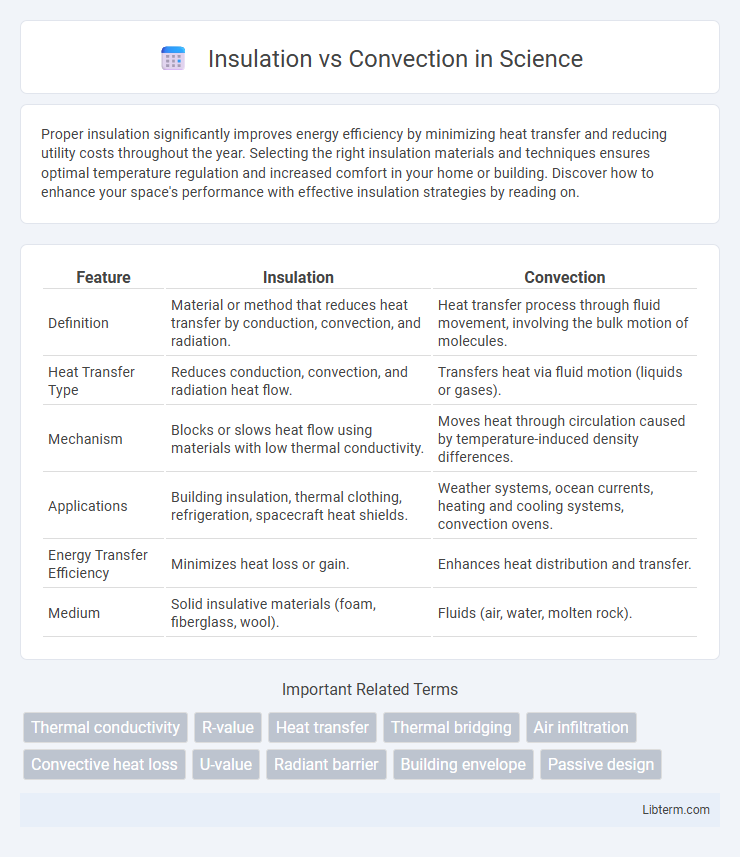Proper insulation significantly improves energy efficiency by minimizing heat transfer and reducing utility costs throughout the year. Selecting the right insulation materials and techniques ensures optimal temperature regulation and increased comfort in your home or building. Discover how to enhance your space's performance with effective insulation strategies by reading on.
Table of Comparison
| Feature | Insulation | Convection |
|---|---|---|
| Definition | Material or method that reduces heat transfer by conduction, convection, and radiation. | Heat transfer process through fluid movement, involving the bulk motion of molecules. |
| Heat Transfer Type | Reduces conduction, convection, and radiation heat flow. | Transfers heat via fluid motion (liquids or gases). |
| Mechanism | Blocks or slows heat flow using materials with low thermal conductivity. | Moves heat through circulation caused by temperature-induced density differences. |
| Applications | Building insulation, thermal clothing, refrigeration, spacecraft heat shields. | Weather systems, ocean currents, heating and cooling systems, convection ovens. |
| Energy Transfer Efficiency | Minimizes heat loss or gain. | Enhances heat distribution and transfer. |
| Medium | Solid insulative materials (foam, fiberglass, wool). | Fluids (air, water, molten rock). |
Introduction to Insulation and Convection
Insulation reduces heat transfer by creating a barrier that slows the movement of thermal energy, enhancing energy efficiency in buildings and appliances. Convection involves the transfer of heat through fluid motion, such as air or water currents, which can significantly impact heating and cooling processes. Understanding the differences between insulation and convection is crucial for designing effective thermal management systems.
What is Insulation?
Insulation is a material or method used to reduce the transfer of heat between objects or environments, effectively maintaining temperature control by minimizing heat loss or gain. It works by trapping air or other gases, which are poor conductors of heat, thereby slowing down thermal conduction and convection processes. Common insulation materials include fiberglass, foam, and cellulose, each designed to improve energy efficiency in buildings by preventing heat flow.
What is Convection?
Convection is the process of heat transfer through the movement of fluids such as air, water, or gases, where warmer, less dense fluid rises and cooler, denser fluid sinks, creating a circulation pattern that distributes heat. This mechanism is fundamental in natural phenomena like ocean currents and atmospheric weather patterns, as well as in engineered systems such as heating and cooling appliances. Understanding convection is essential for optimizing insulation strategies, as effective insulation slows down heat movement by minimizing convective heat flow within building materials.
Key Differences Between Insulation and Convection
Insulation reduces heat transfer by creating a barrier that minimizes conduction, convection, and radiation, effectively maintaining temperature by preventing energy loss. Convection involves the movement of fluids (liquids or gases) transferring heat through the circulation of warmer and cooler areas. The key difference lies in insulation actively blocking heat flow, whereas convection facilitates heat transfer through fluid motion.
How Insulation Works: Mechanisms Explained
Insulation works by reducing heat transfer through conduction, convection, and radiation, trapping air or other gases within materials to slow down thermal energy movement. Materials like fiberglass, foam, and reflective barriers create resistance to heat flow, minimizing temperature changes inside buildings. Effective insulation disrupts convection currents by preventing warm air from rising and cold air from sinking, maintaining a stable indoor climate.
How Convection Works: Principles and Examples
Convection works by transferring heat through the movement of fluids or gases, where warmer, less dense material rises and cooler, denser material sinks, creating a continuous circulation pattern. This natural process is evident in atmospheric phenomena, ocean currents, and household heating systems like radiators, which distribute heat efficiently via air or water flow. Understanding convection principles is crucial for designing effective thermal management solutions in buildings, engines, and environmental systems.
Real-World Applications of Insulation
Insulation significantly reduces heat transfer by creating barriers that limit convection currents within walls, attics, and pipes, enhancing energy efficiency in residential and commercial buildings. Materials like fiberglass, foam, and cellulose trap air, minimizing convective heat loss and maintaining consistent indoor temperatures. Proper insulation application lowers heating and cooling costs, improves comfort, and reduces greenhouse gas emissions in HVAC systems.
Real-World Applications of Convection
Convection plays a crucial role in real-world applications such as heating systems, where warm air circulates to evenly distribute heat within buildings, improving energy efficiency. In industrial processes, convection facilitates the cooling of machinery by transferring heat through fluid movement, preventing overheating and equipment damage. Natural convection also drives weather patterns, influencing climate and environmental conditions critical for agriculture and urban planning.
Comparing Efficiency: Insulation vs Convection
Insulation minimizes heat transfer by creating barriers that reduce conductive and radiative heat loss, resulting in higher energy efficiency compared to convection. Convection relies on fluid movement, such as air or water, to transfer heat, which can cause more rapid heat dissipation in poorly controlled environments. Superior insulation materials like spray foam or fiberglass outperform convection methods by maintaining consistent internal temperatures and reducing energy consumption in heating and cooling systems.
Choosing the Right Solution: Factors to Consider
Choosing the right solution between insulation and convection hinges on factors such as thermal resistance, energy efficiency requirements, and environmental conditions. Insulation materials with high R-values reduce heat transfer, making them ideal for static temperature control, while convection methods effectively manage heat distribution in dynamic environments through fluid or air movement. Consider the building design, climate, cost, and intended application to balance long-term savings and comfort.
Insulation Infographic

 libterm.com
libterm.com